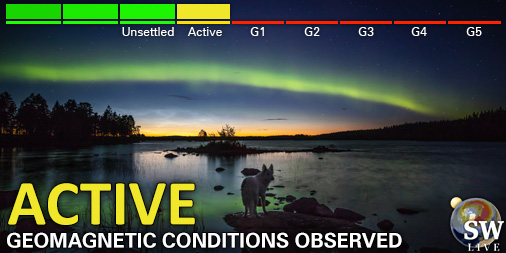Visualizzazione archivio di venerdì, 6 aprile AM
Rapporto attività solare
Preparati dal SWPC della NOAA© ed elaborati da SpaceWeatherLive.com
Rapporto Congiunto USAF/NOAA dell'Attività Solare e Geofisica
SDF Numero 096 Emesso alle 2200Z il Apr 06 2001IA. Analisi delle Regioni Solari Attive e Attività dalle 2100Z-05 alle 2100Z-06
IB. Previsione dell'Attività Solare
IIA. Sommario dell'Attività Geofisica dalle 2100Z-05 alle 2100Z-06
IIB. Previsione dell'Attività Geofisica
III. Probabilità dell'Evento dalle Apr del 07 alle Apr del 09
| Classe M | 80% | 80% | 80% |
| Classe X | 25% | 25% | 25% |
| Protone | 60% | 25% | 25% |
| PCAF | yellow | ||
IV. Flusso di 10.7 cm di Penticton
Osservato 06 Apr 192 Previsto 07 Apr-09 Apr 200/195/190 Media di 90 Giorni 06 Apr 167
V. Indici Geomagnetici A
Osservato Afr/Ap 05 Apr 011/019 Stimato Afr/Ap 06 Apr 012/015 Previsto Afr/Ap 07 Apr-09 Apr 012/012-025/025-025/025
VI. Probabilità dell'Attività Geomagnetica dal 07 Apr al 09 Apr
| A. Latitudini Medie | |||
|---|---|---|---|
| Attivo | 20% | 35% | 35% |
| Tempesta minore | 10% | 20% | 20% |
| Tempesta maggiore-grave | 05% | 25% | 30% |
| B. Latitudini Alte | |||
|---|---|---|---|
| Attivo | 25% | 40% | 40% |
| Tempesta minore | 15% | 25% | 25% |
| Tempesta maggiore-grave | 05% | 15% | 30% |
Tutti gli orari in UTC
<< Vai alla pagina della panoramica giornaliera
I dati attuali suggeriscono ci sia una lieve possibilità perché l'aurora compaia alle seguenti regioni ad alta altitudine nel futuro prossimo
Yellowknife, NTUltime notizie
Ultimi messaggi dal forum
Supporta SpaceWeatherLive.com!
Molte persone vengono su SpaceWeatherLive per seguire l'attività del Sole o sapere se ci sia la possibilità di vedere l'aurora, ma a maggior traffico corrispondono costi maggiori. Considerate una donazione se vi piace SpaceWeatherLive così che possiamo mantenere online il sito web!

Ultimi avvisi
04:15 UTC - Attività geomagnetica
Condizioni geomagnetiche attive (Kp4) Soglia Raggiunta: 03:57 UTC
02:30 UTC - Indice di potenza emisferica
Il modello OVATION prevede che l'indice di potenza emisferica raggiunga i 50GW alle 03:23 UTC
mercoledì, 16 aprile PM
21:45 UTC - Attività geomagnetica
Tempesta geomagnetica G1 minore (Kp5) Soglia Raggiunta: 21:36 UTC
21:00 UTC - Attività geomagnetica
Tempesta geomagnetica G1 grave (Kp5) Soglia Raggiunta: 20:55 UTC
19:45 UTC - Attività geomagnetica
Tempesta geomagnetica G1 forte (Kp5) Soglia Raggiunta: 19:25 UTC
Notizie sul meteo spaziale
| Ultimo brillamento X | 2025/03/28 | X1.1 |
| Ultimo brillamento M | 2025/04/15 | M1.2 |
| Ultima tempesta geomagnetica | 2025/04/16 | Kp8- (G4) |
| Giorni senza macchie | |
|---|---|
| Ultimo giorno senza macchie | 2022/06/08 |
| Media mensile Numero di Macchie Solari | |
|---|---|
| marzo 2025 | 134.2 -20.4 |
| aprile 2025 | 120.5 -13.7 |
| Ultimi 30 giorni | 118.3 -22.1 |






